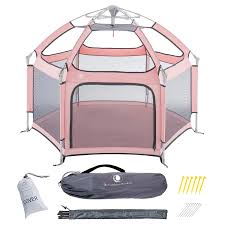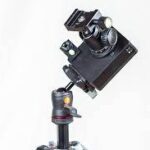The use of a pop up playpen is an increasingly popular choice among parents and caregivers of young children. It provides babies with a safe, contained space to explore and play in while under supervision. While pop up playpens can be used from birth, it is important to consider the age at which they should be introduced in order to ensure the safety and wellbeing of your child.
Setting the Scene

When it comes to setting up a safe play area for your baby, a pop-up playpen can be an excellent option. These playpens are lightweight and easy to set up, making them perfect for parents on the go. However, many parents may wonder at what age their baby should start using a pop-up playpen.
Generally speaking, most babies can start using a pop-up playpen around the age of six months or when they begin to crawl. At this point in their development, babies are becoming more mobile and curious about their surroundings. A pop-up playpen provides a contained space where they can explore and learn without being exposed to potential hazards.
It’s important to note that every child is different, and some babies may not be ready for a pop-up playpen until later on in their development. As always, it’s essential to closely monitor your child while they’re playing in the playpen and ensure that it’s set up correctly with no loose parts or gaps that could pose a safety risk.
Benefits of Using a Playpen
A playpen is a safe and secure space for babies to play, rest, and explore their surroundings. While there is no specific age at which a baby should start using a pop-up playpen, it is generally recommended that parents use it as soon as they feel comfortable leaving their little ones unattended for short periods.
One of the main benefits of using a playpen is that it provides a safe area for babies to move around freely without the risk of injury or accidents. Parents can keep an eye on their child from afar while they tend to other tasks or take some much-needed time for themselves.
Another advantage of using a pop-up playpen is that it helps babies develop essential motor skills by allowing them to crawl, stand, and walk around in a safe environment. The mesh fabric walls provide good visibility so infants can see and interact with their surroundings while still being contained in one place. Overall, using a playpen offers numerous benefits for both parents and babies alike.
What Age is Appropriate?

When it comes to baby gear, parents often wonder what age is appropriate for each item. One common product that parents may consider purchasing is a pop up playpen. These playpens can be great for keeping babies contained in a safe and controlled area while allowing them to play and explore. However, the question remains: what age is appropriate for a baby to use a pop up playpen?
Generally speaking, most experts recommend waiting until a baby is at least six months old before introducing them to a playpen. At this age, babies are typically able to sit up independently and have better control over their movements. This means they will be less likely to accidentally roll or crawl out of the pen and more able to engage with the toys and activities inside.
Of course, every baby develops at their own pace so it’s important for parents to use their best judgement when deciding whether or not their child is ready for a pop up playpen. Additionally, parents should always closely supervise their child when they are in the pen to ensure safety and avoid accidents.
Safety Considerations
When it comes to using a pop-up playpen for your baby, safety should be the top priority. While there is no specific age requirement for using a playpen, it’s important to consider your baby’s developmental milestones and abilities. Generally, babies who are able to sit up independently or crawl would benefit from using a playpen as it provides them with a safe environment to explore and play without constant supervision.
When selecting a pop-up playpen, make sure it meets safety standards such as having sturdy sides that cannot be easily pushed over by your baby. It’s also important to ensure there are no small parts or sharp edges on the playpen that could harm your baby. Additionally, always supervise your child while they’re playing in the playpen and remove any toys or objects that could pose a choking hazard.
Overall, careful consideration of safety considerations when selecting and using a pop-up playpen can help ensure that both you and your little one have peace of mind while they enjoy their new environment.
Comfort & Entertainment Factors
When it comes to babies, safety is always the top priority. Pop up playpens are a great way to keep your baby safe while providing them with some entertainment. However, there is no one-size-fits-all answer when it comes to determining what age a baby should use a pop up playpen.
It largely depends on the individual baby’s development and ability to move around independently. Most babies start crawling around six months of age, which may be a good time to introduce them to a pop up playpen that can keep them contained while giving them space to explore and play. However, some babies may not start crawling until they are closer to nine or ten months old, in which case you may want to wait until they are more mobile before introducing a playpen.
Ultimately, it’s important for parents and caregivers to closely monitor their baby’s development and abilities before deciding when it’s appropriate for them to use a pop up playpen. By doing so, you can ensure that your little one is both safe and entertained during their early stages of growth and exploration.
Considerations for Parents
When it comes to using a pop-up playpen for your baby, there are several considerations that parents should keep in mind. Firstly, it’s important to ensure that the playpen is appropriate for your child’s age and developmental stage. Many pop-up playpens are designed for use from birth up until around 3 years of age, but some may be more suited to older toddlers.
Another important consideration is safety. Parents should always choose a playpen with sturdy construction and secure locking mechanisms to prevent their little one from escaping or toppling over the fence. Additionally, parents should ensure that any toys or items placed inside the playpen are safe and appropriate for their child’s age.
Lastly, parents should consider their specific needs and lifestyle when choosing a pop-up playpen. Some models are better suited for travel due to their lightweight design and compact foldability while others may offer more space or features such as removable changing stations or storage pockets. By taking these factors into account, parents can find a pop-up playpen that meets both their baby’s needs and their own practical requirements.
In conclusion, it is recommended that pop up playpens should not be used for babies under six months of age. This is because younger infants are more vulnerable to Sudden Infant Death Syndrome (SIDS) and other risks such as suffocation or entrapment. It is important to follow the manufacturer’s guidelines and instructions when setting up and using a playpen.
For babies older than six months, pop up playpens can be a great tool for keeping them safe and contained while providing them with a comfortable place to play. However, it is important to always supervise your baby while they are in the playpen and ensure that there are no small objects or hazards within reach.
Overall, pop up playpens can be a convenient and safe option for parents with active babies who need a designated space to play. By following safety guidelines and using common sense, parents can provide their little ones with an enjoyable environment while also ensuring their safety at all times.





Leave a Reply